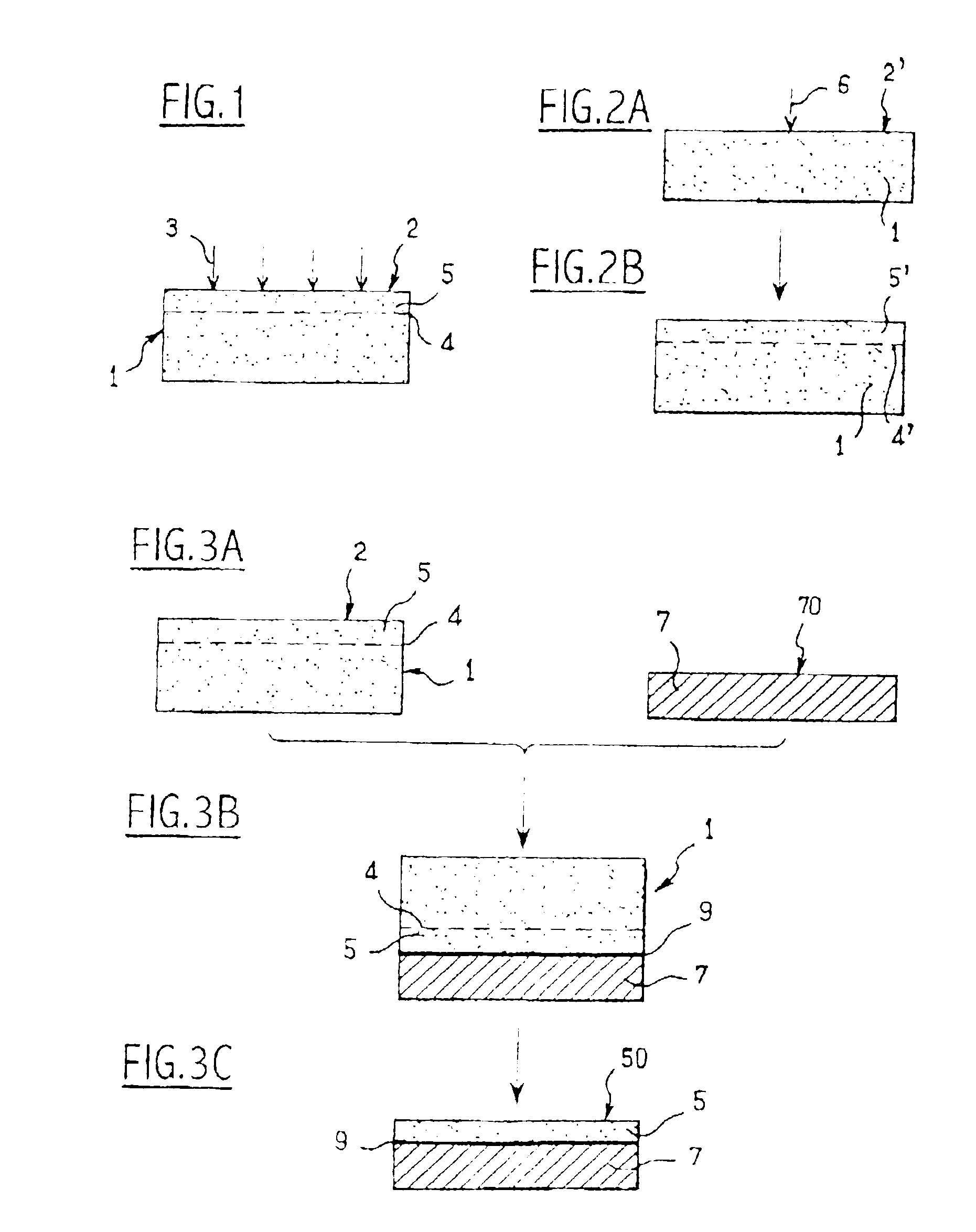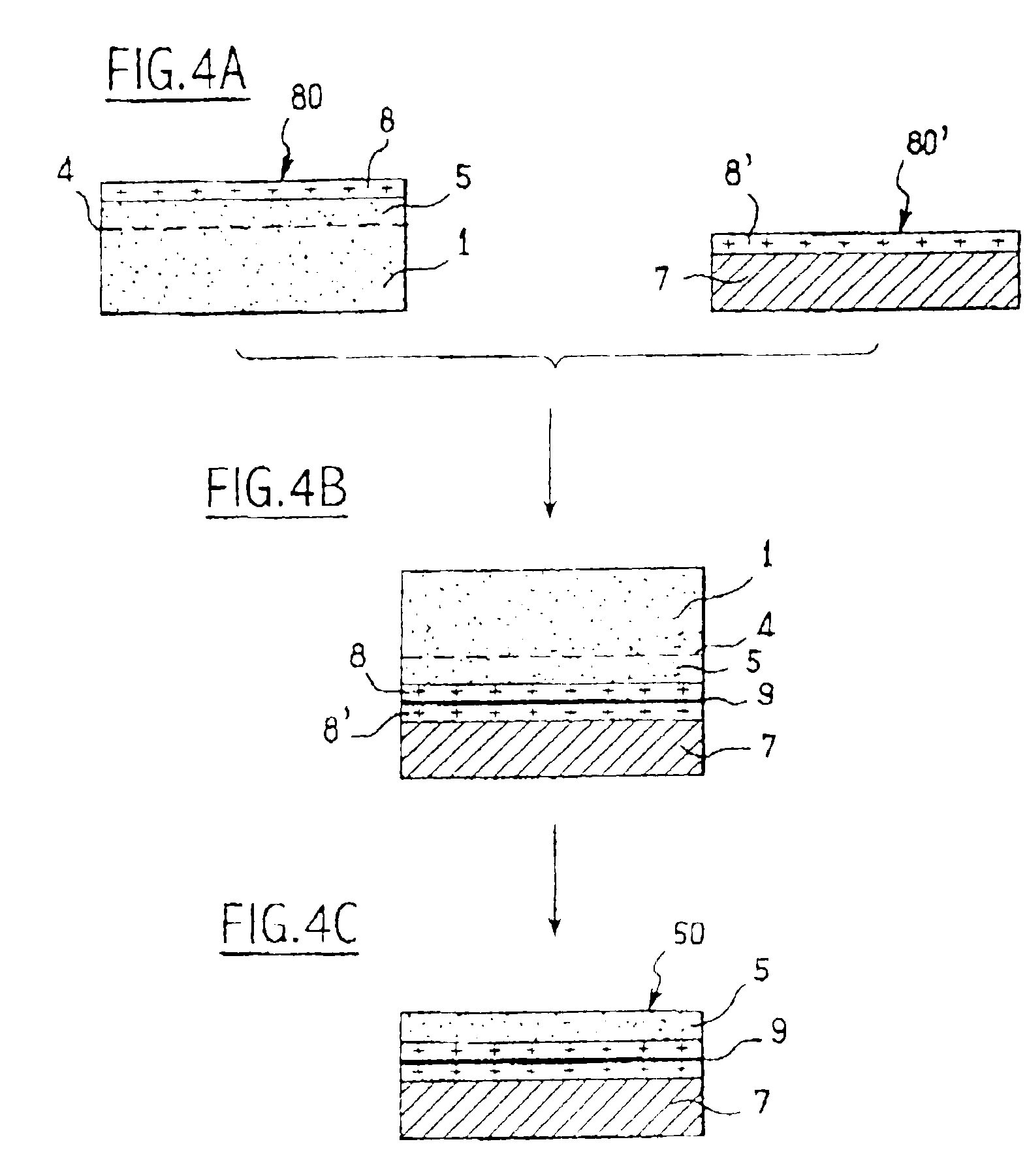Method of manufacturing a free-standing substrate made of monocrystalline semi-conductor material
a manufacturing method and semiconductor technology, applied in the direction of polycrystalline material growth, crystal growth process, chemically reactive gas, etc., can solve the problems of difficult implementation of conditions, poor crystalline quality obtained, and no manufacturing method for gan or aln ingots that can be used on an industrial development scale, so as to improve the crystal quality of the deposited third material
- Summary
- Abstract
- Description
- Claims
- Application Information
AI Technical Summary
Benefits of technology
Problems solved by technology
Method used
Image
Examples
example 1
[0107]Manufacturing of a free-standing GaN substrate using an intermediate stack comprising a silicon Si support, two intermediate SiO2 / SiO2 bonding layers and a monocrystalline GaN nucleation layer.
[0108]A monocrystalline gallium nitride (GaN) nucleation layer 5 is formed in a solid source substrate 1 of solid GaN by ion implantation. This nucleation layer 5 is bonded onto a silicon mechanical support 7 by two intermediate bonding layers 8, 8′ of SiO2 bonded together along a bonding interface 9.
[0109]Prior to being assembled together, the two intermediate layers 8, 8′ undergo mechano-chemical planarization and surface treatment intended to increase roughness of the opposing surfaces 80, 80′ (e.g., a treatment with hydrofluoric acid HF or with a chemical cleaning solution known to the skilled artisan the name SC1 and comprised principally of ammonia diluted with hydrogen peroxide H2O2) of the opposing surfaces 80, 80′).
[0110]Then the nucleation layer 5 is detached from the rest of t...
example 2
[0118]Manufacturing of a free-standing AlN substrate using an intermediate stack comprising a silicon Si support, intermediate SiO2 / SiO2 bonding layers and a monocrystalline AlN nucleation layer.
[0119]One proceeds in identical fashion as described for Example 1, except that the solid gallium nitride is replaced by aluminum nitride (AlN) and that the different AlN layers have a coefficient of thermal expansion in the area of 4.15×10−16 / K, while the coefficient of thermal expansion of the silicon forming the support is 2.5×10−6 / K.
[0120]Removal is done likewise naturally by lowering the temperature of the stack.
example 3
[0121]Manufacturing of a free-standing GaN substrate using an intermediate stack comprising a silicon support, a single intermediate bonding layer of SiO2 and a silicon Si {111} nucleation layer.
[0122]A nucleation layer 5 of silicon {111} is formed in a source substrate 1 of the same type by ion implantation. This nucleation layer 5 is bonded onto a silicon mechanical support 7 by an intermediate bonding layer 8 of SiO2 obtained by thermal oxidation of the top surface of the source substrate 1. The bonding interface 9 is disposed between the top surface 80 of the SiO2 layer and the frontal surface 2 of the nucleation layer 5.
[0123]This bonding interface 9 is treated as in Example 1 so as to be removable.
[0124]Then the nucleation layer 5 is removed from the rest of the source substrate 1 along the embrittled zone 4.
[0125]A finishing step is then operated on the exposed surface 50 of the nucleation layer 5.
[0126]Then fast growth of a GaN layer 10 by HVPE at 1050° C. is realized. At th...
PUM
| Property | Measurement | Unit |
|---|---|---|
| thickness | aaaaa | aaaaa |
| thickness | aaaaa | aaaaa |
| diameter | aaaaa | aaaaa |
Abstract
Description
Claims
Application Information
 Login to View More
Login to View More - R&D
- Intellectual Property
- Life Sciences
- Materials
- Tech Scout
- Unparalleled Data Quality
- Higher Quality Content
- 60% Fewer Hallucinations
Browse by: Latest US Patents, China's latest patents, Technical Efficacy Thesaurus, Application Domain, Technology Topic, Popular Technical Reports.
© 2025 PatSnap. All rights reserved.Legal|Privacy policy|Modern Slavery Act Transparency Statement|Sitemap|About US| Contact US: help@patsnap.com



